Company Accounting Case Study Assessment 2 - ACCT6005 Analysis
VerifiedAdded on 2022/12/14
|10
|1843
|451
Case Study
AI Summary
This document presents a complete solution to the ACCT6005 Company Accounting case study, addressing both the theoretical and practical aspects of the assessment. Part A analyzes the theoretical framework of company accounting, specifically focusing on shareholder rights, the power to dismiss managers, and the requirements for various corporate actions like constitutional changes and election of directors. It also discusses the implications of shareholder consent in different scenarios and the rights of shareholders to take decisions against board desires. Part B provides a practical application through acquisition analysis, journal entries, and a consolidation worksheet. The worksheet includes consolidated financial statements, incorporating adjustments for intercompany transactions and fair value adjustments. The document also presents consolidated financial statements and discusses the assets, equity, and liabilities. It provides a detailed breakdown of the financial data, including sales, cost of sales, profit, and various balance sheet items, offering a comprehensive understanding of the consolidation process and the resulting financial statements.

Paraphrase This Document
Need a fresh take? Get an instant paraphrase of this document with our AI Paraphraser

Company Accounting

Contents
PART A.......................................................................................................................................................................... 4
PART B.......................................................................................................................................................................... 5
REFERENCES.............................................................................................................................................................10
PART A.......................................................................................................................................................................... 4
PART B.......................................................................................................................................................................... 5
REFERENCES.............................................................................................................................................................10
⊘ This is a preview!⊘
Do you want full access?
Subscribe today to unlock all pages.

Trusted by 1+ million students worldwide
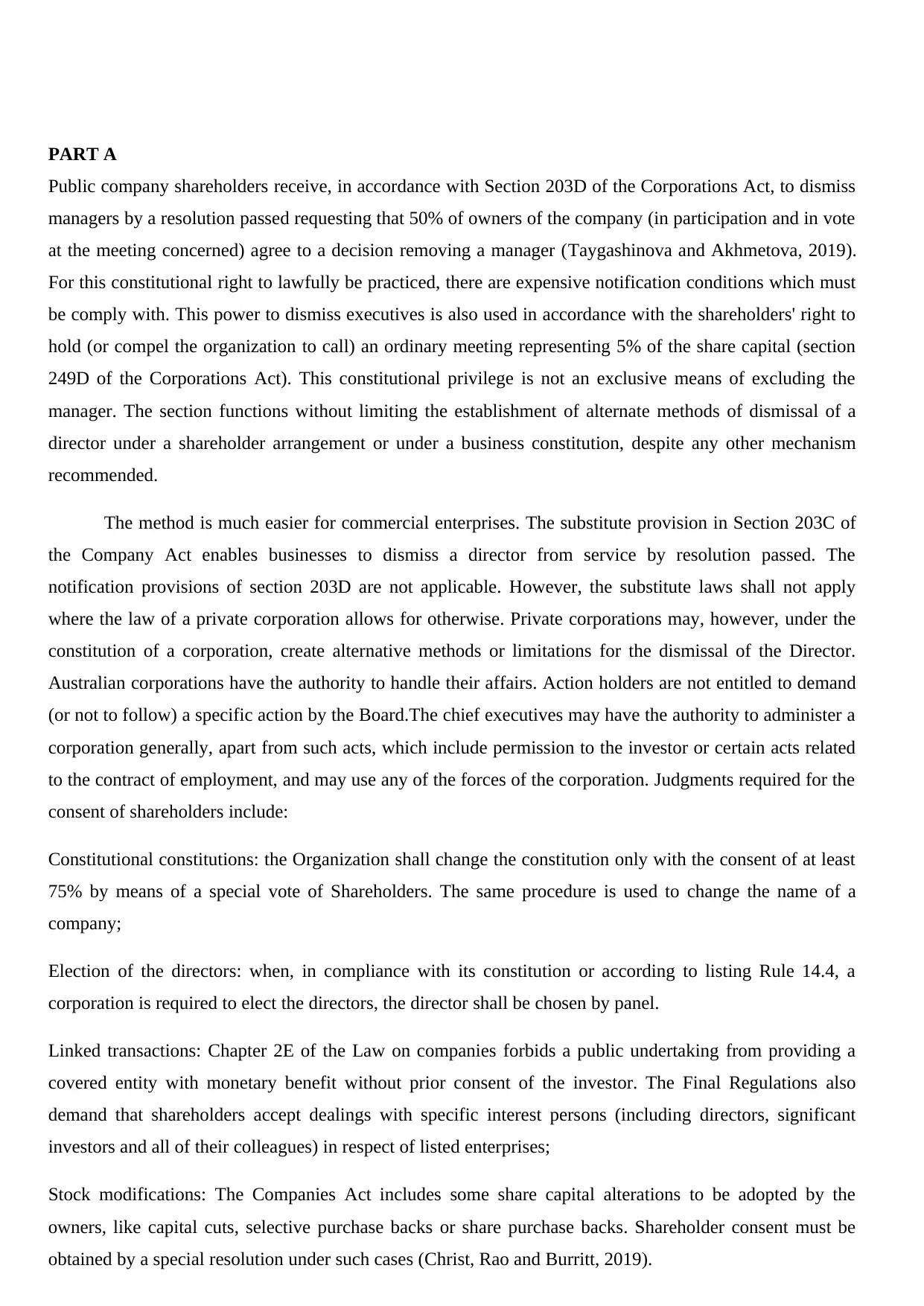
PART A
Public company shareholders receive, in accordance with Section 203D of the Corporations Act, to dismiss
managers by a resolution passed requesting that 50% of owners of the company (in participation and in vote
at the meeting concerned) agree to a decision removing a manager (Taygashinova and Akhmetova, 2019).
For this constitutional right to lawfully be practiced, there are expensive notification conditions which must
be comply with. This power to dismiss executives is also used in accordance with the shareholders' right to
hold (or compel the organization to call) an ordinary meeting representing 5% of the share capital (section
249D of the Corporations Act). This constitutional privilege is not an exclusive means of excluding the
manager. The section functions without limiting the establishment of alternate methods of dismissal of a
director under a shareholder arrangement or under a business constitution, despite any other mechanism
recommended.
The method is much easier for commercial enterprises. The substitute provision in Section 203C of
the Company Act enables businesses to dismiss a director from service by resolution passed. The
notification provisions of section 203D are not applicable. However, the substitute laws shall not apply
where the law of a private corporation allows for otherwise. Private corporations may, however, under the
constitution of a corporation, create alternative methods or limitations for the dismissal of the Director.
Australian corporations have the authority to handle their affairs. Action holders are not entitled to demand
(or not to follow) a specific action by the Board.The chief executives may have the authority to administer a
corporation generally, apart from such acts, which include permission to the investor or certain acts related
to the contract of employment, and may use any of the forces of the corporation. Judgments required for the
consent of shareholders include:
Constitutional constitutions: the Organization shall change the constitution only with the consent of at least
75% by means of a special vote of Shareholders. The same procedure is used to change the name of a
company;
Election of the directors: when, in compliance with its constitution or according to listing Rule 14.4, a
corporation is required to elect the directors, the director shall be chosen by panel.
Linked transactions: Chapter 2E of the Law on companies forbids a public undertaking from providing a
covered entity with monetary benefit without prior consent of the investor. The Final Regulations also
demand that shareholders accept dealings with specific interest persons (including directors, significant
investors and all of their colleagues) in respect of listed enterprises;
Stock modifications: The Companies Act includes some share capital alterations to be adopted by the
owners, like capital cuts, selective purchase backs or share purchase backs. Shareholder consent must be
obtained by a special resolution under such cases (Christ, Rao and Burritt, 2019).
Public company shareholders receive, in accordance with Section 203D of the Corporations Act, to dismiss
managers by a resolution passed requesting that 50% of owners of the company (in participation and in vote
at the meeting concerned) agree to a decision removing a manager (Taygashinova and Akhmetova, 2019).
For this constitutional right to lawfully be practiced, there are expensive notification conditions which must
be comply with. This power to dismiss executives is also used in accordance with the shareholders' right to
hold (or compel the organization to call) an ordinary meeting representing 5% of the share capital (section
249D of the Corporations Act). This constitutional privilege is not an exclusive means of excluding the
manager. The section functions without limiting the establishment of alternate methods of dismissal of a
director under a shareholder arrangement or under a business constitution, despite any other mechanism
recommended.
The method is much easier for commercial enterprises. The substitute provision in Section 203C of
the Company Act enables businesses to dismiss a director from service by resolution passed. The
notification provisions of section 203D are not applicable. However, the substitute laws shall not apply
where the law of a private corporation allows for otherwise. Private corporations may, however, under the
constitution of a corporation, create alternative methods or limitations for the dismissal of the Director.
Australian corporations have the authority to handle their affairs. Action holders are not entitled to demand
(or not to follow) a specific action by the Board.The chief executives may have the authority to administer a
corporation generally, apart from such acts, which include permission to the investor or certain acts related
to the contract of employment, and may use any of the forces of the corporation. Judgments required for the
consent of shareholders include:
Constitutional constitutions: the Organization shall change the constitution only with the consent of at least
75% by means of a special vote of Shareholders. The same procedure is used to change the name of a
company;
Election of the directors: when, in compliance with its constitution or according to listing Rule 14.4, a
corporation is required to elect the directors, the director shall be chosen by panel.
Linked transactions: Chapter 2E of the Law on companies forbids a public undertaking from providing a
covered entity with monetary benefit without prior consent of the investor. The Final Regulations also
demand that shareholders accept dealings with specific interest persons (including directors, significant
investors and all of their colleagues) in respect of listed enterprises;
Stock modifications: The Companies Act includes some share capital alterations to be adopted by the
owners, like capital cuts, selective purchase backs or share purchase backs. Shareholder consent must be
obtained by a special resolution under such cases (Christ, Rao and Burritt, 2019).
Paraphrase This Document
Need a fresh take? Get an instant paraphrase of this document with our AI Paraphraser
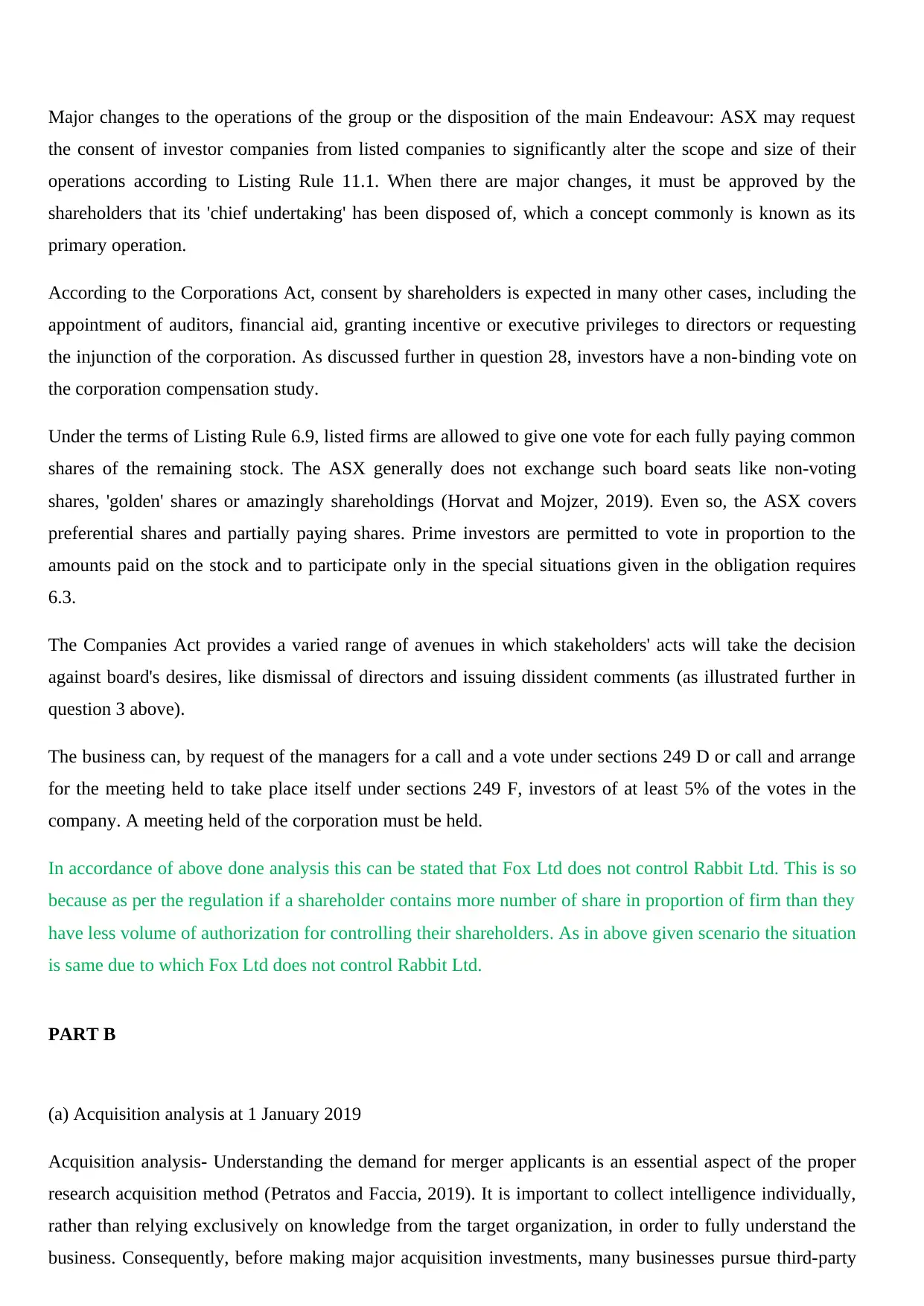
Major changes to the operations of the group or the disposition of the main Endeavour: ASX may request
the consent of investor companies from listed companies to significantly alter the scope and size of their
operations according to Listing Rule 11.1. When there are major changes, it must be approved by the
shareholders that its 'chief undertaking' has been disposed of, which a concept commonly is known as its
primary operation.
According to the Corporations Act, consent by shareholders is expected in many other cases, including the
appointment of auditors, financial aid, granting incentive or executive privileges to directors or requesting
the injunction of the corporation. As discussed further in question 28, investors have a non-binding vote on
the corporation compensation study.
Under the terms of Listing Rule 6.9, listed firms are allowed to give one vote for each fully paying common
shares of the remaining stock. The ASX generally does not exchange such board seats like non-voting
shares, 'golden' shares or amazingly shareholdings (Horvat and Mojzer, 2019). Even so, the ASX covers
preferential shares and partially paying shares. Prime investors are permitted to vote in proportion to the
amounts paid on the stock and to participate only in the special situations given in the obligation requires
6.3.
The Companies Act provides a varied range of avenues in which stakeholders' acts will take the decision
against board's desires, like dismissal of directors and issuing dissident comments (as illustrated further in
question 3 above).
The business can, by request of the managers for a call and a vote under sections 249 D or call and arrange
for the meeting held to take place itself under sections 249 F, investors of at least 5% of the votes in the
company. A meeting held of the corporation must be held.
In accordance of above done analysis this can be stated that Fox Ltd does not control Rabbit Ltd. This is so
because as per the regulation if a shareholder contains more number of share in proportion of firm than they
have less volume of authorization for controlling their shareholders. As in above given scenario the situation
is same due to which Fox Ltd does not control Rabbit Ltd.
PART B
(a) Acquisition analysis at 1 January 2019
Acquisition analysis- Understanding the demand for merger applicants is an essential aspect of the proper
research acquisition method (Petratos and Faccia, 2019). It is important to collect intelligence individually,
rather than relying exclusively on knowledge from the target organization, in order to fully understand the
business. Consequently, before making major acquisition investments, many businesses pursue third-party
the consent of investor companies from listed companies to significantly alter the scope and size of their
operations according to Listing Rule 11.1. When there are major changes, it must be approved by the
shareholders that its 'chief undertaking' has been disposed of, which a concept commonly is known as its
primary operation.
According to the Corporations Act, consent by shareholders is expected in many other cases, including the
appointment of auditors, financial aid, granting incentive or executive privileges to directors or requesting
the injunction of the corporation. As discussed further in question 28, investors have a non-binding vote on
the corporation compensation study.
Under the terms of Listing Rule 6.9, listed firms are allowed to give one vote for each fully paying common
shares of the remaining stock. The ASX generally does not exchange such board seats like non-voting
shares, 'golden' shares or amazingly shareholdings (Horvat and Mojzer, 2019). Even so, the ASX covers
preferential shares and partially paying shares. Prime investors are permitted to vote in proportion to the
amounts paid on the stock and to participate only in the special situations given in the obligation requires
6.3.
The Companies Act provides a varied range of avenues in which stakeholders' acts will take the decision
against board's desires, like dismissal of directors and issuing dissident comments (as illustrated further in
question 3 above).
The business can, by request of the managers for a call and a vote under sections 249 D or call and arrange
for the meeting held to take place itself under sections 249 F, investors of at least 5% of the votes in the
company. A meeting held of the corporation must be held.
In accordance of above done analysis this can be stated that Fox Ltd does not control Rabbit Ltd. This is so
because as per the regulation if a shareholder contains more number of share in proportion of firm than they
have less volume of authorization for controlling their shareholders. As in above given scenario the situation
is same due to which Fox Ltd does not control Rabbit Ltd.
PART B
(a) Acquisition analysis at 1 January 2019
Acquisition analysis- Understanding the demand for merger applicants is an essential aspect of the proper
research acquisition method (Petratos and Faccia, 2019). It is important to collect intelligence individually,
rather than relying exclusively on knowledge from the target organization, in order to fully understand the
business. Consequently, before making major acquisition investments, many businesses pursue third-party
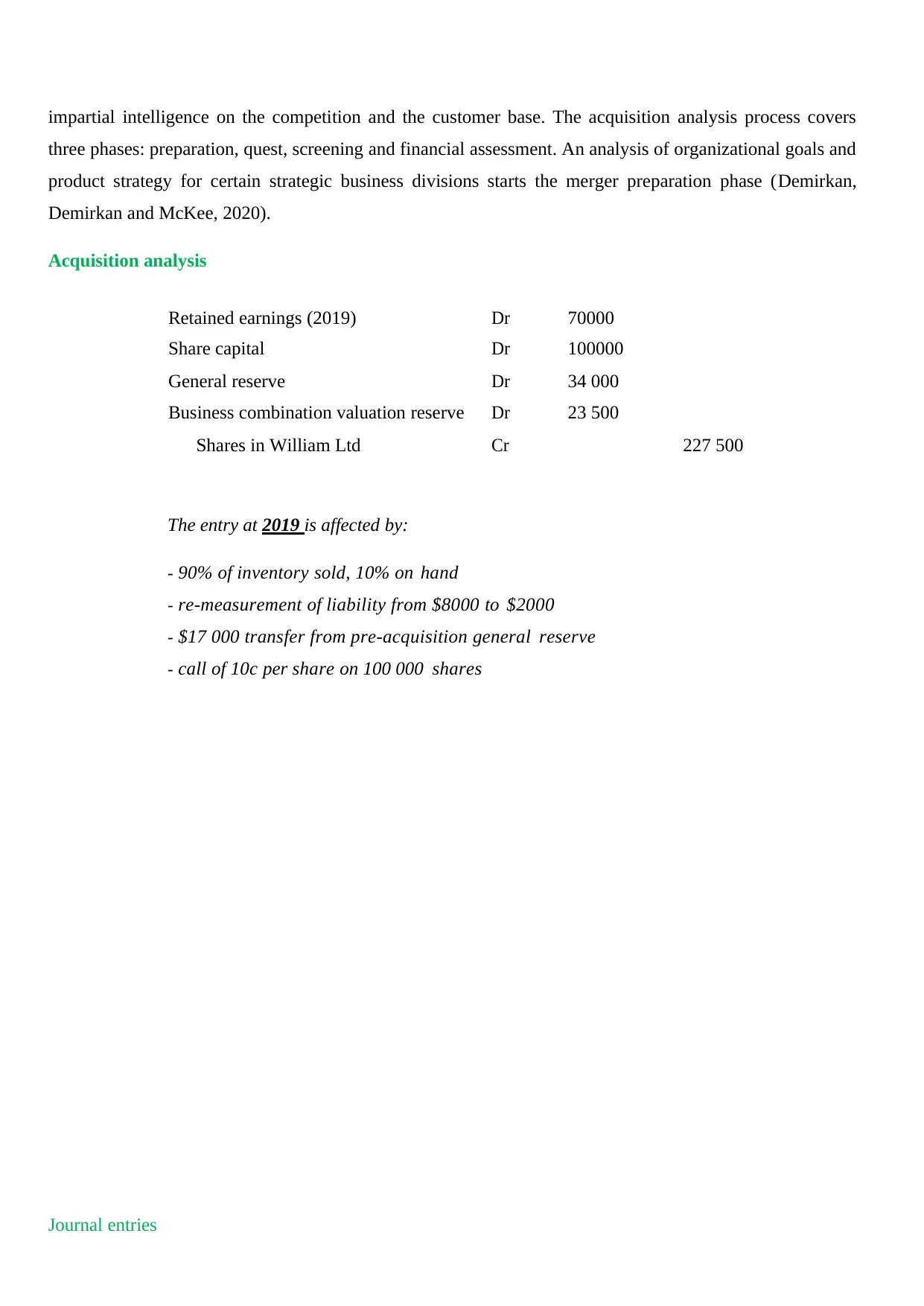
impartial intelligence on the competition and the customer base. The acquisition analysis process covers
three phases: preparation, quest, screening and financial assessment. An analysis of organizational goals and
product strategy for certain strategic business divisions starts the merger preparation phase (Demirkan,
Demirkan and McKee, 2020).
Acquisition analysis
Retained earnings (2019) Dr 70000
Share capital Dr 100000
General reserve Dr 34 000
Business combination valuation reserve Dr 23 500
Shares in William Ltd Cr 227 500
The entry at 2019 is affected by:
- 90% of inventory sold, 10% on hand
- re-measurement of liability from $8000 to $2000
- $17 000 transfer from pre-acquisition general reserve
- call of 10c per share on 100 000 shares
Journal entries
three phases: preparation, quest, screening and financial assessment. An analysis of organizational goals and
product strategy for certain strategic business divisions starts the merger preparation phase (Demirkan,
Demirkan and McKee, 2020).
Acquisition analysis
Retained earnings (2019) Dr 70000
Share capital Dr 100000
General reserve Dr 34 000
Business combination valuation reserve Dr 23 500
Shares in William Ltd Cr 227 500
The entry at 2019 is affected by:
- 90% of inventory sold, 10% on hand
- re-measurement of liability from $8000 to $2000
- $17 000 transfer from pre-acquisition general reserve
- call of 10c per share on 100 000 shares
Journal entries
⊘ This is a preview!⊘
Do you want full access?
Subscribe today to unlock all pages.

Trusted by 1+ million students worldwide
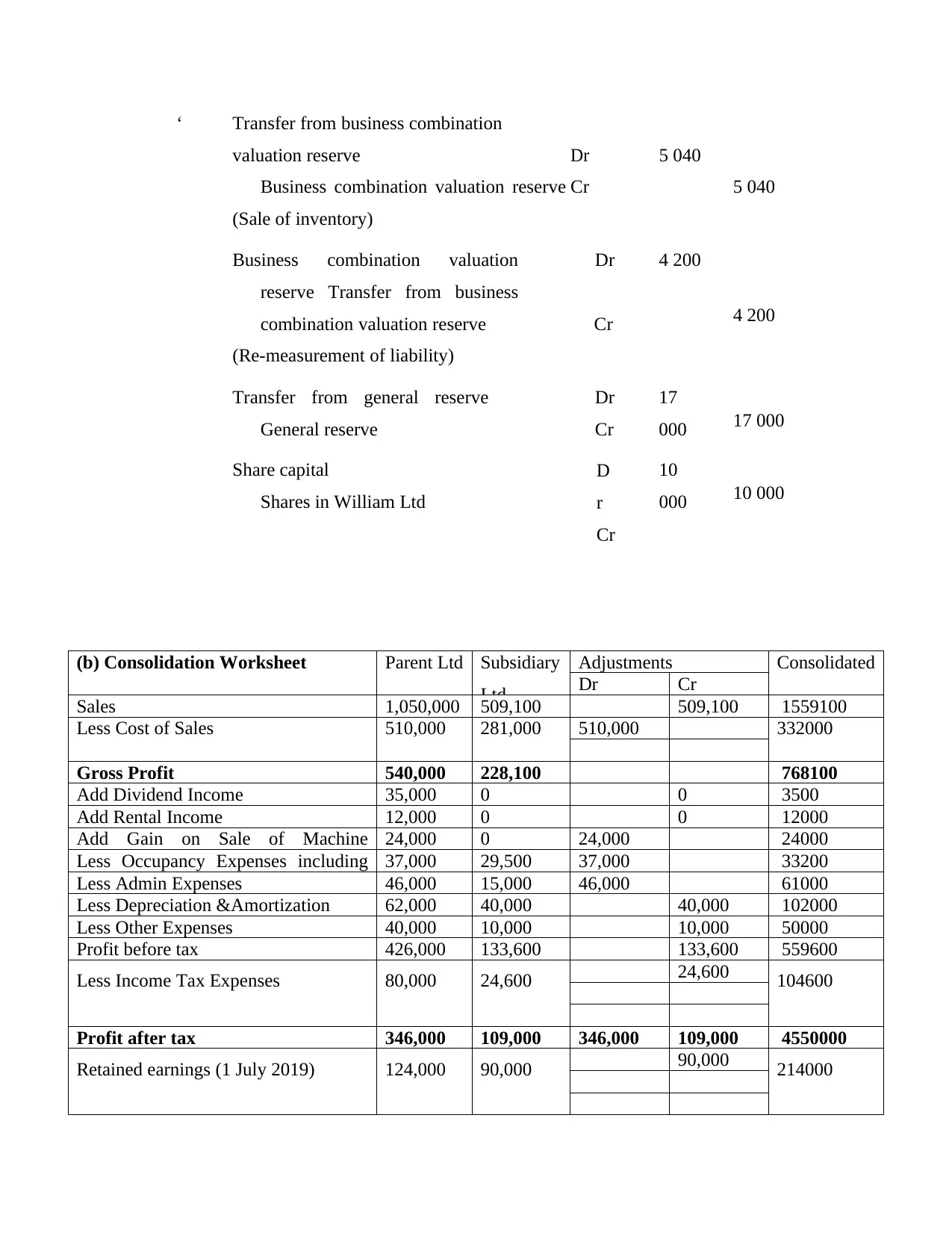
‘ Transfer from business combination
valuation reserve Dr 5 040
Business combination valuation reserve
(Sale of inventory)
Cr 5 040
Business combination valuation
reserve Transfer from business
combination valuation reserve
Dr
Cr
4 200
4 200
(Re-measurement of liability)
Transfer from general reserve
General reserve
Dr
Cr
17
000 17 000
Share capital
Shares in William Ltd
D
r
Cr
10
000 10 000
(b) Consolidation Worksheet Parent Ltd Subsidiary
Ltd
Adjustments Consolidated
Dr Cr
Sales 1,050,000 509,100 509,100 1559100
Less Cost of Sales 510,000 281,000 510,000 332000
Gross Profit 540,000 228,100 768100
Add Dividend Income 35,000 0 0 3500
Add Rental Income 12,000 0 0 12000
Add Gain on Sale of Machine 24,000 0 24,000 24000
Less Occupancy Expenses including 37,000 29,500 37,000 33200
Less Admin Expenses 46,000 15,000 46,000 61000
Less Depreciation &Amortization 62,000 40,000 40,000 102000
Less Other Expenses 40,000 10,000 10,000 50000
Profit before tax 426,000 133,600 133,600 559600
Less Income Tax Expenses 80,000 24,600 24,600 104600
Profit after tax 346,000 109,000 346,000 109,000 4550000
Retained earnings (1 July 2019) 124,000 90,000 90,000 214000
valuation reserve Dr 5 040
Business combination valuation reserve
(Sale of inventory)
Cr 5 040
Business combination valuation
reserve Transfer from business
combination valuation reserve
Dr
Cr
4 200
4 200
(Re-measurement of liability)
Transfer from general reserve
General reserve
Dr
Cr
17
000 17 000
Share capital
Shares in William Ltd
D
r
Cr
10
000 10 000
(b) Consolidation Worksheet Parent Ltd Subsidiary
Ltd
Adjustments Consolidated
Dr Cr
Sales 1,050,000 509,100 509,100 1559100
Less Cost of Sales 510,000 281,000 510,000 332000
Gross Profit 540,000 228,100 768100
Add Dividend Income 35,000 0 0 3500
Add Rental Income 12,000 0 0 12000
Add Gain on Sale of Machine 24,000 0 24,000 24000
Less Occupancy Expenses including 37,000 29,500 37,000 33200
Less Admin Expenses 46,000 15,000 46,000 61000
Less Depreciation &Amortization 62,000 40,000 40,000 102000
Less Other Expenses 40,000 10,000 10,000 50000
Profit before tax 426,000 133,600 133,600 559600
Less Income Tax Expenses 80,000 24,600 24,600 104600
Profit after tax 346,000 109,000 346,000 109,000 4550000
Retained earnings (1 July 2019) 124,000 90,000 90,000 214000
Paraphrase This Document
Need a fresh take? Get an instant paraphrase of this document with our AI Paraphraser
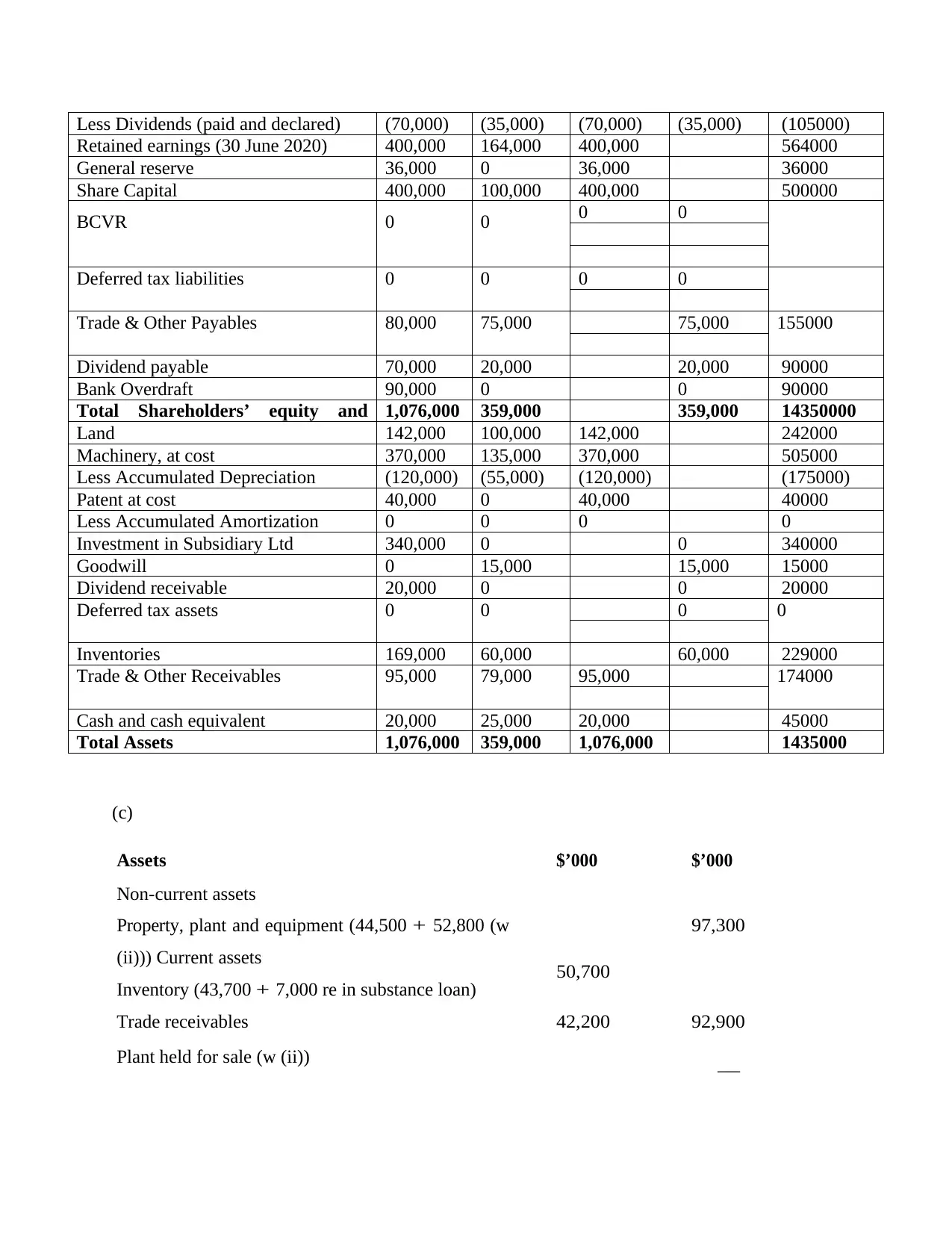
Less Dividends (paid and declared) (70,000) (35,000) (70,000) (35,000) (105000)
Retained earnings (30 June 2020) 400,000 164,000 400,000 564000
General reserve 36,000 0 36,000 36000
Share Capital 400,000 100,000 400,000 500000
BCVR 0 0 0 0
Deferred tax liabilities 0 0 0 0
Trade & Other Payables 80,000 75,000 75,000 155000
Dividend payable 70,000 20,000 20,000 90000
Bank Overdraft 90,000 0 0 90000
Total Shareholders’ equity and 1,076,000 359,000 359,000 14350000
Land 142,000 100,000 142,000 242000
Machinery, at cost 370,000 135,000 370,000 505000
Less Accumulated Depreciation (120,000) (55,000) (120,000) (175000)
Patent at cost 40,000 0 40,000 40000
Less Accumulated Amortization 0 0 0 0
Investment in Subsidiary Ltd 340,000 0 0 340000
Goodwill 0 15,000 15,000 15000
Dividend receivable 20,000 0 0 20000
Deferred tax assets 0 0 0 0
Inventories 169,000 60,000 60,000 229000
Trade & Other Receivables 95,000 79,000 95,000 174000
Cash and cash equivalent 20,000 25,000 20,000 45000
Total Assets 1,076,000 359,000 1,076,000 1435000
(c)
Assets
Non-current assets
$’000 $’000
Property, plant and equipment (44,500 + 52,800 (w
(ii))) Current assets
Inventory (43,700 + 7,000 re in substance loan) 50,700
97,300
Trade receivables 42,200 92,900
Plant held for sale (w (ii)) ––
Retained earnings (30 June 2020) 400,000 164,000 400,000 564000
General reserve 36,000 0 36,000 36000
Share Capital 400,000 100,000 400,000 500000
BCVR 0 0 0 0
Deferred tax liabilities 0 0 0 0
Trade & Other Payables 80,000 75,000 75,000 155000
Dividend payable 70,000 20,000 20,000 90000
Bank Overdraft 90,000 0 0 90000
Total Shareholders’ equity and 1,076,000 359,000 359,000 14350000
Land 142,000 100,000 142,000 242000
Machinery, at cost 370,000 135,000 370,000 505000
Less Accumulated Depreciation (120,000) (55,000) (120,000) (175000)
Patent at cost 40,000 0 40,000 40000
Less Accumulated Amortization 0 0 0 0
Investment in Subsidiary Ltd 340,000 0 0 340000
Goodwill 0 15,000 15,000 15000
Dividend receivable 20,000 0 0 20000
Deferred tax assets 0 0 0 0
Inventories 169,000 60,000 60,000 229000
Trade & Other Receivables 95,000 79,000 95,000 174000
Cash and cash equivalent 20,000 25,000 20,000 45000
Total Assets 1,076,000 359,000 1,076,000 1435000
(c)
Assets
Non-current assets
$’000 $’000
Property, plant and equipment (44,500 + 52,800 (w
(ii))) Current assets
Inventory (43,700 + 7,000 re in substance loan) 50,700
97,300
Trade receivables 42,200 92,900
Plant held for sale (w (ii)) ––
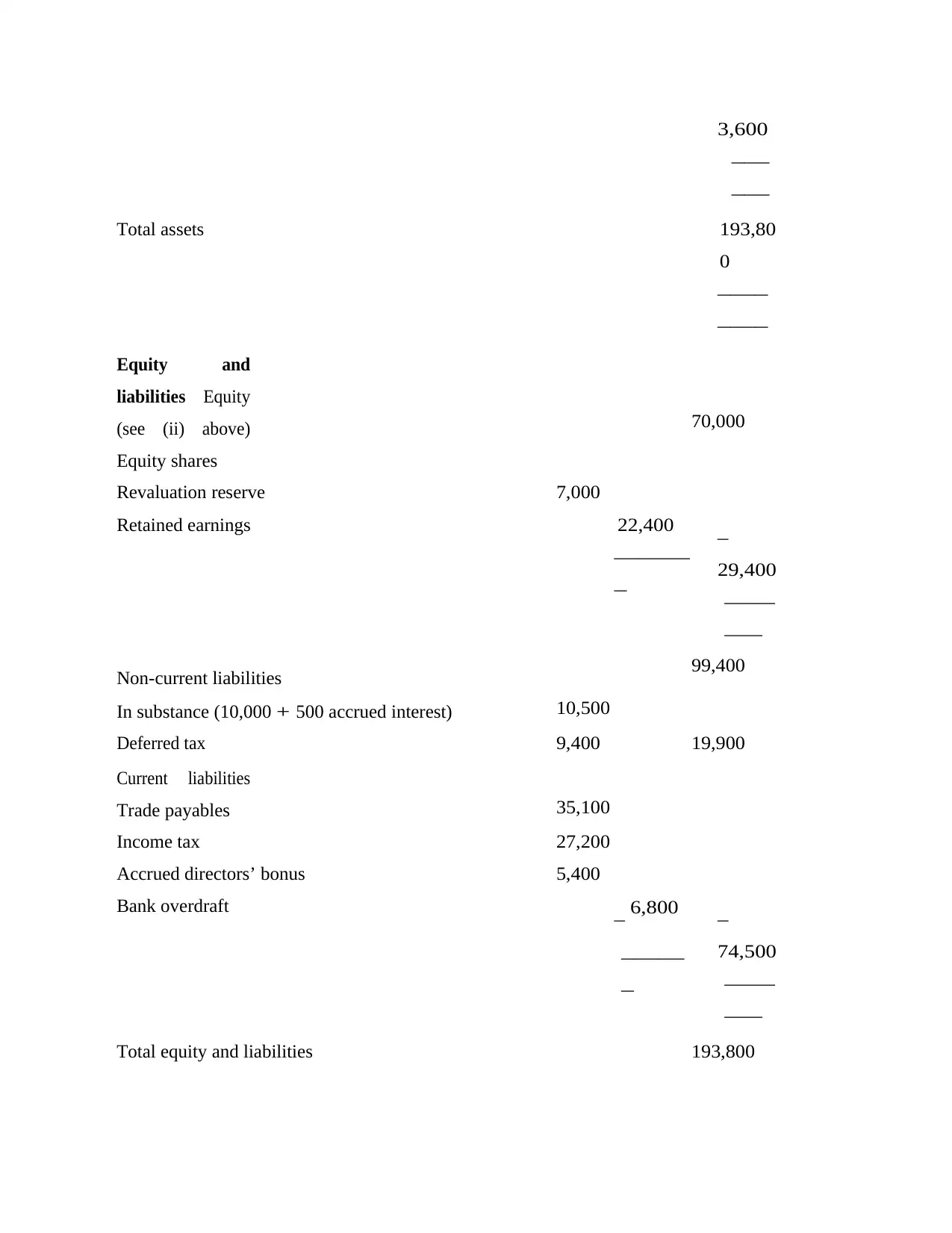
3,600
–––
–––
Total assets 193,80
0
––––
––––
Equity and
liabilities Equity
(see (ii) above)
Equity shares
70,000
Revaluation reserve 7,000
Retained earnings 22,400
––––––
–
–
29,400
––––
–––
Non-current liabilities
In substance (10,000 + 500 accrued interest) 10,500
99,400
Deferred tax 9,400 19,900
Current liabilities
Trade payables 35,100
Income tax 27,200
Accrued directors’ bonus 5,400
Bank overdraft – 6,800
–––––
–
–
74,500
––––
–––
Total equity and liabilities 193,800
–––
–––
Total assets 193,80
0
––––
––––
Equity and
liabilities Equity
(see (ii) above)
Equity shares
70,000
Revaluation reserve 7,000
Retained earnings 22,400
––––––
–
–
29,400
––––
–––
Non-current liabilities
In substance (10,000 + 500 accrued interest) 10,500
99,400
Deferred tax 9,400 19,900
Current liabilities
Trade payables 35,100
Income tax 27,200
Accrued directors’ bonus 5,400
Bank overdraft – 6,800
–––––
–
–
74,500
––––
–––
Total equity and liabilities 193,800
⊘ This is a preview!⊘
Do you want full access?
Subscribe today to unlock all pages.

Trusted by 1+ million students worldwide
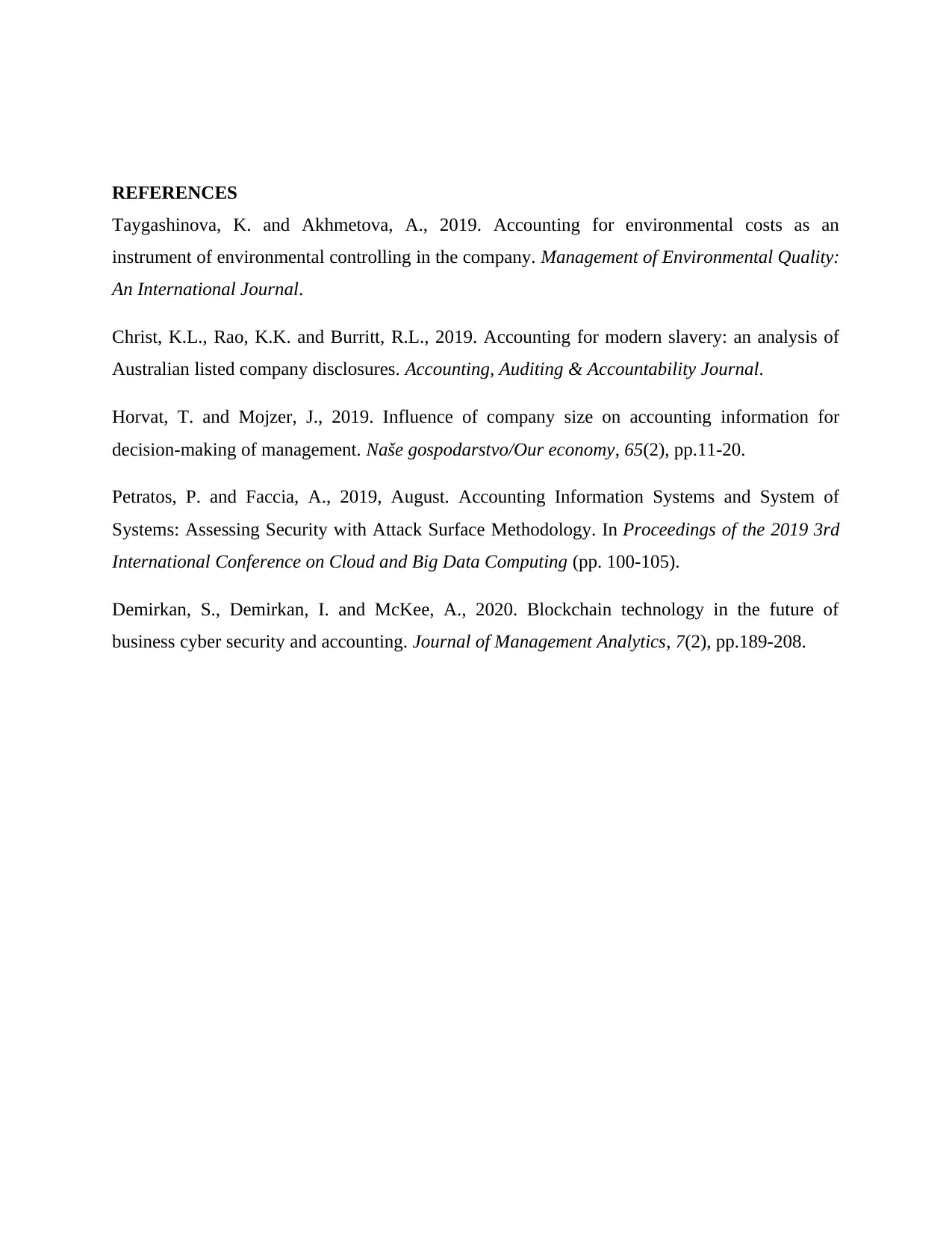
REFERENCES
Taygashinova, K. and Akhmetova, A., 2019. Accounting for environmental costs as an
instrument of environmental controlling in the company. Management of Environmental Quality:
An International Journal.
Christ, K.L., Rao, K.K. and Burritt, R.L., 2019. Accounting for modern slavery: an analysis of
Australian listed company disclosures. Accounting, Auditing & Accountability Journal.
Horvat, T. and Mojzer, J., 2019. Influence of company size on accounting information for
decision-making of management. Naše gospodarstvo/Our economy, 65(2), pp.11-20.
Petratos, P. and Faccia, A., 2019, August. Accounting Information Systems and System of
Systems: Assessing Security with Attack Surface Methodology. In Proceedings of the 2019 3rd
International Conference on Cloud and Big Data Computing (pp. 100-105).
Demirkan, S., Demirkan, I. and McKee, A., 2020. Blockchain technology in the future of
business cyber security and accounting. Journal of Management Analytics, 7(2), pp.189-208.
Taygashinova, K. and Akhmetova, A., 2019. Accounting for environmental costs as an
instrument of environmental controlling in the company. Management of Environmental Quality:
An International Journal.
Christ, K.L., Rao, K.K. and Burritt, R.L., 2019. Accounting for modern slavery: an analysis of
Australian listed company disclosures. Accounting, Auditing & Accountability Journal.
Horvat, T. and Mojzer, J., 2019. Influence of company size on accounting information for
decision-making of management. Naše gospodarstvo/Our economy, 65(2), pp.11-20.
Petratos, P. and Faccia, A., 2019, August. Accounting Information Systems and System of
Systems: Assessing Security with Attack Surface Methodology. In Proceedings of the 2019 3rd
International Conference on Cloud and Big Data Computing (pp. 100-105).
Demirkan, S., Demirkan, I. and McKee, A., 2020. Blockchain technology in the future of
business cyber security and accounting. Journal of Management Analytics, 7(2), pp.189-208.
1 out of 10
Related Documents
Your All-in-One AI-Powered Toolkit for Academic Success.
+13062052269
info@desklib.com
Available 24*7 on WhatsApp / Email
![[object Object]](/_next/static/media/star-bottom.7253800d.svg)
Unlock your academic potential
Copyright © 2020–2025 A2Z Services. All Rights Reserved. Developed and managed by ZUCOL.





